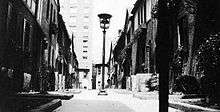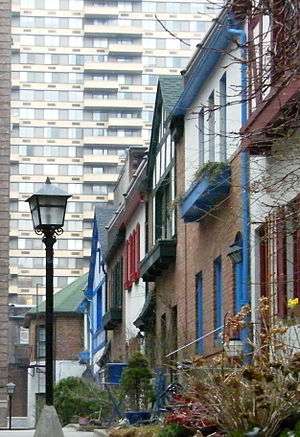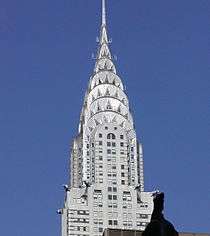Pomander Walk
|
Pomander Walk | |
|
Pomander Walk, facing north. The Columbia (275 West 96th Street) is visible in the background | |
 | |
| Location |
west of Broadway, Manhattan, New York City, New York[1] |
|---|---|
| Built | 1921 |
| Architect | King and Campbell |
| NRHP Reference # | 83001739[2] |
| Significant dates | |
| Added to NRHP | September 14, 1982 |
| Designated NYSL | 1982 |
| Designated NYCL | 1982 |
Coordinates: 40°47′37″N 73°58′23″W / 40.79361°N 73.97306°WPomander Walk is a cooperative apartment complex in Manhattan, New York City, located on the Upper West Side between Broadway and West End Avenue. The complex consists of 27 buildings. Four buildings face West 94th Street, and another seven face West 95th Street, including one with a return facade on West End Avenue. The "Walk" itself, consisting of two rows of eight buildings facing each other across a narrow courtyard, runs through the middle of the block between 94th and 95th, with a locked gate at each end. Each building originally had one apartment on each floor. In recent years, some buildings have been reconfigured to serve as single-family homes.
Pomander Walk is different in style and out of scale with the tall buildings that surround it. Author and former resident Darryl Pinckney called it "an insertion of incredible whimsy" into the Upper West Side.[3] It is not open to the public and visit is by invitation or guided tours only
History

The complex is named for Pomander Walk, a romantic comedy by Louis N. Parker that opened in New York in 1910.[4][5][6] The play is set on an imaginary byway near London. The place as built bears a tenuous resemblance to the setting described in the play as "a retired crescent of five very small, old-fashioned houses near Chiswick, on the river-bank. ... They are exactly alike: miniature copies of Queen Anne mansions".[7] New York City's Pomander Walk is Tudoresque, a style that enjoyed a vogue in America in the years following World War I.
Pomander Walk was built in 1921 by nightclub impresario Thomas J. Healy who planned to build a major hotel on the site. According to city historian Christopher Gray, when Healy was unable to get financing for a hotel, he built the houses that stand on the site today, apparently to provide a temporary cash-flow while he waited to raze them and build the hotel.[4] It was designed by the New York architecture firm King and Campbell.[8] He died in 1927, however, so Pomander Walk remained.[9]
By the 1970s, the complex was rundown and at risk of being demolished. However, it was saved with a City, State, and National Historic Landmark designation in 1982.[9][10] after tenants banded together to block redevelopment.[11] An earlier application for City Landmark status had been rejected in 1966.[12]
In 2009 the owners completed a four-year facade renovation, restoring architectural details that had been lost for decades. In 2008 Landmark West! bestowed their Building Rehabilitation Award on Pomander Walk.[13]
Past residents include Nancy Carroll, Ward Morehouse, Herbert Stothart, Paulette Goddard, and Rosalind Russell.
References
- ↑ Virginia Kurshan (June 1983). "National Register of Historic Places Inventory - Nomination Form: Pomander Walk" (PDF). New York State Cultural Resource Information System. Retrieved 2015-06-15. 11 Photos (1983)
- ↑ National Park Service (2010-07-09). "National Register Information System". National Register of Historic Places. National Park Service.
- ↑ Silvers, Robert B.; Epstein, Barbara (2006). The Company They Kept: Writers on Unforgettable Friendships. New York: New York Review Books. p. 135. ISBN 1-59017-203-5.
- 1 2 Gray, Christopher (January 16, 2000). "Pomander Walk, on the Upper West Side; A Tiny Street Where Interim Became Permanent". The New York Times. Retrieved 2012-01-15.
- ↑ "Pomander Walk". Internet Broadway Database.
- ↑ "New York to have a 'Pomander Walk': Street of Little Houses, Lawns, Flowers and Fountains in Shadow of Broadway". The New York Times. April 19, 1921. Retrieved 2012-01-15.
- ↑ Parker, Louis N. (1915). Pomander Walk. Samuel French. p. 13.
- ↑ Plunz, Richard (1990). A History of Housing in New York City: Dwelling Type and Social Change in the American Metropolis. New York: Columbia University Press. p. 135. ISBN 0-231-06296-6.
- 1 2 "A Secret World on the Upper West Side: A Trip Down Pomander Walk". Scouting NY. Retrieved 2016-01-22.
- ↑ "Pomander Walk". Landmark West!. Retrieved February 11, 2013. Includes designation report (City) and notification letter (State and National).
- ↑ Jaffe, Eric. "Downton Abbey on the Upper West Side". The Atlantic Cities. Atlantic Media Company. Retrieved 15 February 2013.
- ↑ Gratz, Roberta Brandes (2010). The Battle for Gotham: New York in the Shadow of Robert Moses and Jane Jacobs. Nation Books. p. 53.
- ↑ "Unsung heroes of the Upper West Side". Landmark West!. Retrieved February 11, 2013.



